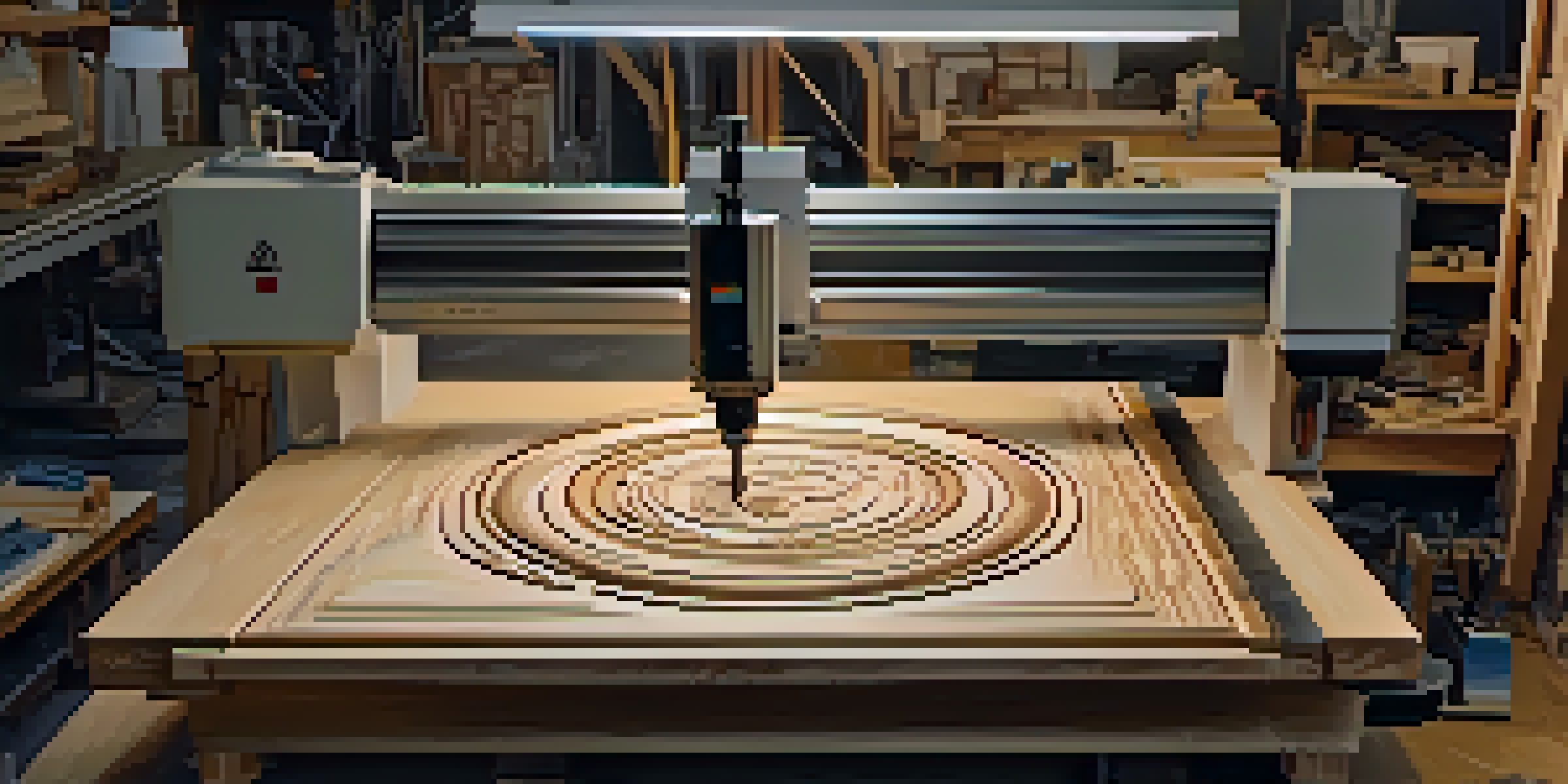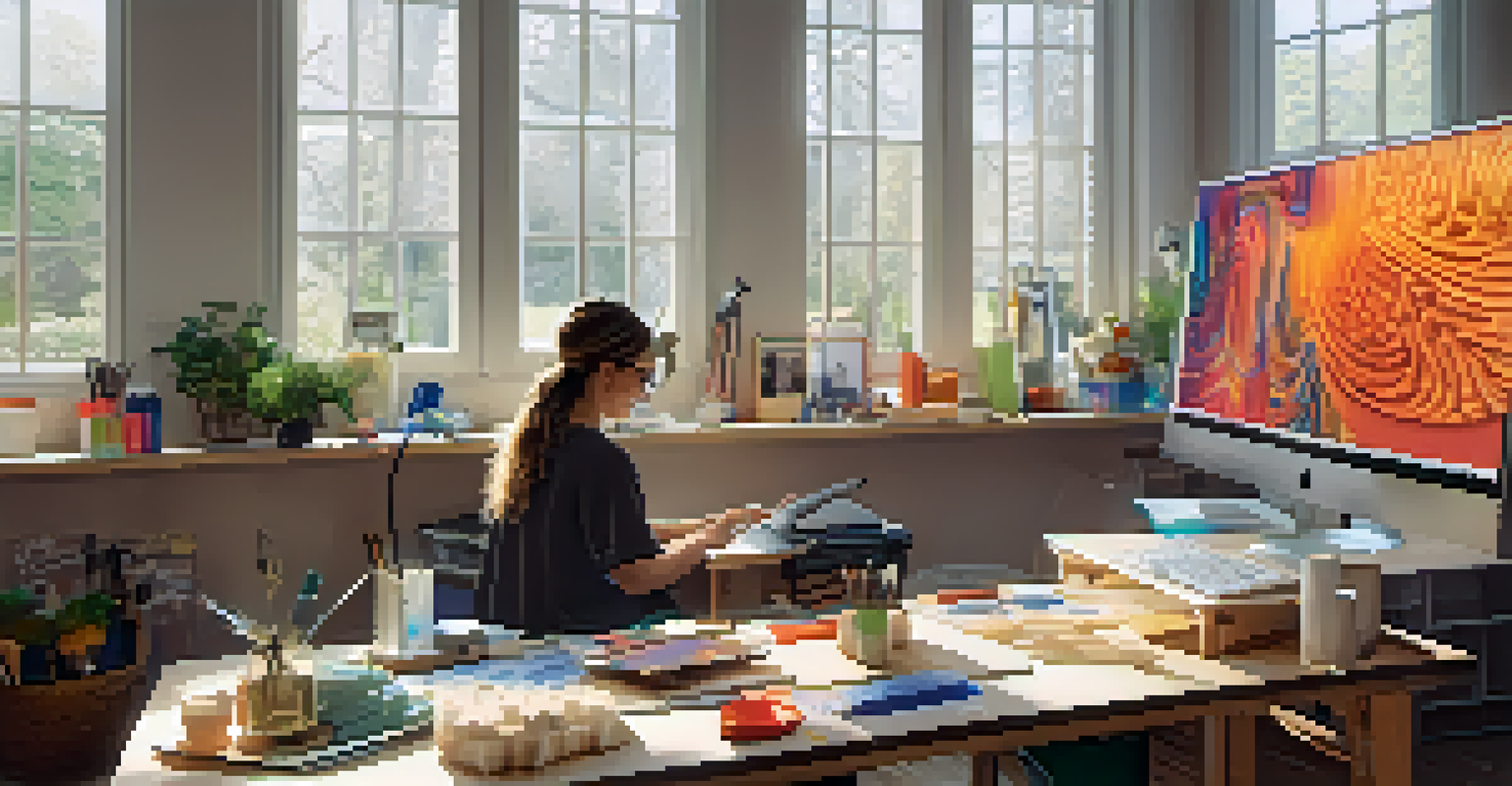Understanding Digital Carving Techniques for Modern Artistry

What is Digital Carving and Its Significance?
Digital carving blends traditional sculpting techniques with modern technology, allowing artists to create intricate designs with precision. Unlike traditional carving, which relies on physical tools, digital carving utilizes software and machines like CNC routers or 3D printers. This evolution in artistry opens up new possibilities for creativity and expression, making it an essential skill for contemporary artists.
Art is not what you see, but what you make others see.
The significance of digital carving lies in its ability to democratize art-making. Artists of various skill levels can experiment with complex forms without needing extensive training in traditional techniques. As a result, we see a diversification in artistic voices and styles, enriching the overall art community.
Moreover, digital carving promotes sustainability in art production. By minimizing material waste and allowing for rapid prototyping, artists can explore new designs without the fear of resource depletion. This shift not only benefits creators but also aligns with the growing demand for environmentally conscious practices in the arts.
Essential Tools for Digital Carving Mastery
To embark on your digital carving journey, you'll need a few key tools. A computer with powerful design software, like Adobe Illustrator or Rhino, is crucial for crafting your digital models. Additionally, a CNC machine or a 3D printer is necessary to bring your designs into the physical realm, transforming your digital creations into tangible works of art.

One of the most exciting aspects of digital carving tools is the variety of options available. For instance, CNC routers can handle various materials, from wood to stone, while laser cutters offer precision for intricate designs. Understanding the strengths and limitations of each tool empowers artists to choose the best fit for their creative vision.
Digital Carving: A New Art Frontier
Digital carving merges traditional techniques with modern technology, empowering artists to create intricate designs with precision.
Investing in quality tools can significantly enhance your digital carving projects. While it might be tempting to go for budget options, high-quality machines and software can lead to more reliable results and a smoother workflow. It's often said that the right tools can make all the difference in an artist's journey, and this is especially true in digital carving.
The Process of Digital Carving Explained
Digital carving begins with the design phase, where artists create a 3D model using specialized software. This model serves as a blueprint for the carving process, allowing for intricate detailing and adjustments before production. Once the design is finalized, it is translated into a format compatible with the CNC machine or printer.
Creativity takes courage.
Next comes the actual carving process, where the machine follows the digital instructions to sculpt the material. This step is where the magic happens; the machine's precision can replicate even the most delicate features of the design. It's fascinating how technology can bring our ideas to life with such accuracy, often surpassing what we could achieve by hand.
Finally, after the carving is complete, artists often engage in post-processing to refine their work. This might include sanding, painting, or applying finishes to enhance the final piece's appearance. The combination of digital precision and traditional finishing techniques results in unique artworks that reflect both modern technology and the artist's individual touch.
Digital Carving Techniques: Subtractive vs. Additive
In the realm of digital carving, there are two primary techniques: subtractive and additive. Subtractive carving involves removing material from a solid block to reveal the desired shape, much like traditional sculpting. This method is commonly used in CNC routing and can create stunning, intricate designs that showcase the beauty of the material itself.
On the other hand, additive carving builds up material layer by layer, as seen in 3D printing. This technique allows for greater complexity and experimentation, giving artists the freedom to explore forms that would be difficult to achieve through subtraction. Each method has its unique advantages, and many artists find that combining both techniques leads to innovative results.
Tools Enhance Creative Possibilities
A variety of tools like CNC machines and 3D printers are essential for artists, allowing them to bring their digital models to life.
Understanding these techniques is crucial for artists looking to expand their skill set. By experimenting with both subtractive and additive processes, you can discover new ways to express your creativity. This exploration not only broadens your artistic toolkit but also inspires fresh ideas and approaches to your work.
Applications of Digital Carving in Modern Art
Digital carving has found its way into various artistic disciplines, from sculpture to jewelry design and even architecture. Artists are leveraging this technology to push the boundaries of their creativity and explore new dimensions in their work. For instance, sculptors can create complex forms that were previously impossible, while jewelers can craft intricate patterns that enhance the beauty of their pieces.
In architecture, digital carving plays a vital role in creating unique facades and structural elements. Architects can use digital tools to design complex shapes that not only serve functional purposes but also become striking visual statements. This integration of technology in architecture reflects a broader trend in the modern art world, where innovation and creativity go hand in hand.
Moreover, the versatility of digital carving allows for collaborative projects across disciplines. Artists, designers, and architects can come together to create interdisciplinary works that challenge conventional boundaries. This collaborative spirit fosters a vibrant artistic community, where ideas flow freely and inspire new forms of expression.
Challenges and Limitations of Digital Carving
While digital carving opens up exciting possibilities, it also comes with its share of challenges. One of the most significant hurdles is the steep learning curve associated with mastering design software and machine operation. Beginners may feel overwhelmed by the technical aspects, but with practice and patience, they can gradually build their skills and confidence.
Another challenge is the initial investment required for quality tools and materials. High-quality CNC machines and printers can be costly, which may deter some aspiring artists. However, there are often community workshops and shared studios that provide access to these resources, helping to alleviate some of the financial burdens.
Future Innovations in Digital Carving
The future of digital carving promises advancements in technology and collaboration, leading to innovative artistic expressions.
Finally, as with any artistic medium, there are limitations to what can be achieved through digital carving. Some designs may not translate well to physical form, and the technology may have constraints regarding materials and intricacy. Recognizing these limitations can actually inspire artists to think creatively and find innovative solutions to overcome obstacles in their work.
The Future of Digital Carving in Art and Design
As technology continues to evolve, the future of digital carving looks promising. Innovations in software and machinery are making it easier for artists to create complex designs with greater precision and efficiency. This advancement not only enhances the artistic process but also allows for more sustainable practices in the production of art.
Furthermore, the rise of virtual reality and augmented reality technologies is set to revolutionize the experience of digital carving. Artists may soon be able to visualize and manipulate their creations in immersive environments, leading to entirely new forms of artistic expression. Such developments could redefine how artists interact with their work and inspire fresh ideas.

Ultimately, the future of digital carving will likely be characterized by collaboration and cross-disciplinary exploration. As artists from various fields come together to share their knowledge and skills, we can expect to see innovative projects that challenge conventional notions of art and design. This collaborative approach is what will keep the world of digital carving dynamic and continuously evolving.